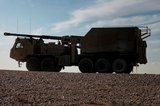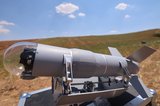USMC upgrades mine clearing system
The US Marine Corps has a new upgraded version of the MK-154 Mine Clearance System that is safer and more reliable than its previous iteration.
The MK-154 was removed from service four years ago following the loss of a marine during a training exercise.
Prior to the upgrade the system was difficult to employ due to intrusion of air into the hydraulic system, which would render the system inoperable. Operators would have to ‘bleed’ the hydraulic system in order to push the air out before it could be used. The upgraded MK-154 Mod 1 includes a self-bleeding hydraulic system that means it can operate with air in the hydraulic lines.
Another new feature is the addition of a capacitor bank to the power distribution box. When the MK-154 is turned on, a crewman will use the AAV power to charge these capacitors. Once charged, the capacitors are used as a backup power source. This makes the new system safer because it can be fired using the backup power source if the AAV loses power.
The system also features a new test system that lets operators know it is safe to fire. The new test box and test firing system have been added to test the firing circuits of the electric system, which are used to simulate live ordnance when plugged into the electric system. Prior to loading live ordnance, crewman plug in the test system and cycle through the firing sequences as if live ordnance were loaded.
During this test, the test box will verify that the MK-154 firing circuitry is safe by the illumination of green lights. If there is a fault in the firing circuitry, the test box will indicate a fault with a red light.
In all, 47 MK-154 Mod 1 systems are being fielded across the marine corps, primarily to Assault Amphibian Battalions. Fielding is expected to be completed by the end of fiscal year 2018.
More from Land Warfare
-
![Land forces review: howitzers in the spotlight and Germany spends big to close the year]()
Land forces review: howitzers in the spotlight and Germany spends big to close the year
December saw several milestones on the howitzer front with billions of dollars worth of orders placed and Germany committing to more 6×6 and 4×4 vehicles. Taiwan was also approved for equipment orders worth $11 billion even as the year came to an end with China encircling the country as part of an exercise.
-
![US Army seeks industry support to prepare acquisitions of Group 4+ UAVs]()
US Army seeks industry support to prepare acquisitions of Group 4+ UAVs
The US Army is keen to hear about vendor designs, strategies and potential hardware and software solutions to inform requirements for procurement efforts.
-
![Dedicated drone munitions could unlock modular mission potential]()
Dedicated drone munitions could unlock modular mission potential
Top attacks have proven effective against heavily armoured vehicles in Ukraine. A new family of uncrewed aerial system-delivered munitions is looking to press that advantage further.
-
![Germany orders 84 Boxer howitzers as UK commits to a single demonstrator]()
Germany orders 84 Boxer howitzers as UK commits to a single demonstrator
Germany has ordered 84 RCH 155 self-propelled guns, as system incorporating Boxer 8×8 vehicles and the Artillery Gun Module, and 200 Puma Infantry Fighting Vehicles while the UK has committed to a single Early Capability Demonstrator RCH 155.























